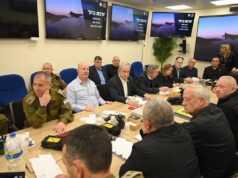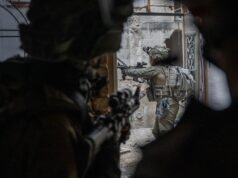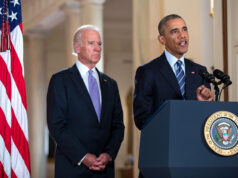The Syrian-Israeli 1967 ceasefire line has been, with few exceptions, quiet since the 1973 Yom Kippur War. While Damascus bitterly repudiates Israel’s conquest of the Golan Heights in the 1967 Six-Day War, it has avoided direct entanglement with the Israel Defense Forces. Instead, Damascus adopted an unofficial policy of dispatching guerrilla proxies in Lebanon to attack Israeli personnel and their south Lebanese allies in the name of “resistance” to Israeli “occupation.”
When Israel unilaterally withdrew its forces from Lebanon in May 2000, Syria faced a strategic conundrum. Specifically, when the United Nations (U.N.) confirmed Israel’s withdrawal to the Blue Line—the internationally recognized Lebanese-Israeli frontier —claims of “occupation” could not be sustained.
To this end, Syria contrived a territorial dispute to justify sponsoring ongoing “resistance” against the Jewish state. This manufactured dispute centers around a small territory commonly known as the Shebaa Farms.
Israel’s Retreat
From 1983 through 2000, thanks to Syrian and Iranian backing, the Shiite militia Hezbollah attacked Israeli soldiers and their Lebanese militia allies. By the late 1990s, amidst mounting fatalities, the military presence in Lebanon had become increasingly unpopular in Israel. The Israeli public favored an exit strategy. Indeed, a poll taken the day after the withdrawal took place showed that it enjoyed the approval of the Israeli public by an overwhelming 72 percent to 20 percent.
Israeli Prime Minister Ehud Barak, elected in 1999 on a platform that included an Israeli exit from Lebanon (“bring our boys home”) within a year, sought to negotiate Israel’s departure in the context of a peace agreement with Syria brokered by U.S. President Bill Clinton. When talks failed, in response to intense domestic pressure, and despite dire warnings from Israeli military strategists, Barak unilaterally withdrew Israel’s forces.
Until then, Damascus believed that Hezbollah was a powerful bargaining chip. Indeed, Syria believed that, in exchange for curbing the Shiite militia’s activities, it could extract concessions in future negotiations that Israel might not have otherwise contemplated.
For example, Syria believed it could insist on Israel withdrawing to the 1949 Israeli-Syrian armistice line, rather than the recognized 1923 international border, thereby permitting Syria to re-occupy sovereign Israeli territory in the Galilee lost by Israel to Syria in the 1948 war. Indeed, Damascus believed that the mere promise of relief and tranquility for Israel on its Lebanese border would serve as incentive for Israel to accept this legally baseless and strategically dangerous border. Syria’s potential leverage, however, dissolved with Israel’s withdrawal.
Hezbollah’s Claim
The Israeli departure also challenged Hezbollah’s raison d’etre. Indeed, without the presence of “Zionist forces” Hezbollah lacked justification for its continued paramilitary activities. The group therefore fabricated a fresh territorial pretext for continued warfare against Israel.
Specifically, Hezbollah charged that seven Lebanese villages—Ibl Qamah, Hounine, Malkieh, Nabi Yusha, Kades, Saliha, and Teir Bikha—were wrongly included in the British Palestine Mandate in 1923, and are thus today “occupied” by Israel.
This alleged error occurred when British and French authorities fixed the boundary between their respective Palestine and Lebanon mandates, pursuant to the 1920 Treaty of Sevres. In the first Arab-Israeli war of 1948-1949, during which Lebanese forces participated in the coordinated Arab assault on Israel, Israeli forces overtook the area and its inhabitants fled to Lebanon.
The seven villages claim, however, was easily challenged. In 1949, after the first Arab-Israeli war, Lebanon demanded that the Israel-Lebanon Mixed Armistice Commission follow the 1923 border. It never lodged with the Commission a claim for possession of the seven villages left on the Israeli side by the consequent Armistice Demarcation Line. Nor were the villages ever mentioned in the 1949 armistice. Similarly, the villages were not mentioned in U.N. Security Council Resolution 425 of March 1978, which called for withdrawal of Israeli forces to Lebanon’s “internationally recognized boundaries.”
Nonetheless, Hezbollah maintains its claim. As recently as November 2008, senior Hezbollah official Nawaf al-Moussawi stated, “The Zionist terrorist organizations moved the border line [between Lebanon and Israel] of 1920 [to the line of] 1923 [and as a result] Lebanon lost its seven villages…”
The Shebaa Farms
Hezbollah, along with its Syrian patron, soon contrived a new territorial claim. Based upon questionable interpretations of mandate-era documents, some eight square miles of Levantine territory became the new Syrian justification for sponsoring continued Hezbollah attacks against Israel.
Though the area in question—the Shebaa Farms—had been part of the Syrian Golan Heights in the post-mandate era, and although it was Syrian territory when Israel conquered it 1967, Syria and Hezbollah concluded that Israel was occupying Lebanese soil. It was therefore land the Syrian-sponsored Lebanese “resistance” would be obliged to “liberate.”
Hezbollah activist Mohammed Raad asserted that the dispute is “a simple matter of geography.” However, as analyst Avi Jorisch noted, Hezbollah has been inconsistent “about exactly what constitutes Shebaa Farms.” Indeed, Jorisch notes Hezbollah has claimed that Shebaa “comprises a set of fourteen farms,” but that it had also equated “Shebaa Farms with the Golan Heights itself.” Curiously, Hezbollah’s website also stated that Israeli tourists travel to the farms to visit the gravesite of the Prophet Abraham, and that Ethiopian Jews had settled there.
It is also important to note that not all Lebanese officials agree with Hezbollah’s claims. For example, Lebanese Druze leader Walid Jumblatt stated in 2005 on al-Arabiyya television that the farms did not constitute a legitimate territorial dispute. “We must end this game that is meant to serve different interests.”
Jumblatt, then an active participant in the anti-Syria Cedar Revolution, was issuing a direct challenge to Syria and its Lebanese agents. Indeed, Jamil al-Sayyid, then-director-general of Lebanon’s General Security Directorate (which took orders directly from Damascus), is rumored to have concocted the Shebaa Farms dispute based on a handful of Ottoman-era property deeds and French Mandate-era maps depicting the Lebanon-Syria boundary as several miles to the south of where it is now. Sayyid, by way of background, is one of four government officials (the other three are Syrian) named in the U.N.’s Detlev Mehlis Report on the 2005 assassination of former Lebanese Prime Minister, Rafiq Hariri.
The United Nations
The Shebaa Farms have little to no significance in the broader Arab-Israeli conflict. Har Dov, as the area is called in Hebrew, consists of fourteen small orchards and pastures. On the Lebanese side of the farms is a remote Sunni region. Yet, when Israel withdrew from Lebanon in May 2000 and the U.N. certified its withdrawal as compliant with international law, the Shebaa Farms became Hezbollah’s battle cry.
The United Nations initially dismissed the claim, citing a lack of supporting documentation. After all, when the U.N. Interim Force in Lebanon (UNIFIL) was established in 1978, Lebanon did not request that the force deploy in Shebaa Farms. Moreover, neither the 1967 Syrian-Israeli ceasefire nor the 1974 Agreement on Disengagement identified the area as Lebanese territory. Even the map of Lebanon appearing on Lebanese currency depicted the area as lying outside Lebanon’s borders.
After six years of controversy, however, the United Nations relented. In the aftermath of the Israeli war against Hezbollah in 2006, U.N. Security Council Resolution 1701 called for the “Delineation of the international borders of Lebanon, especially in those areas where the border is disputed or uncertain, including in the Shebaa farms area.”
Shebaa Today
Today, the Lebanese government presses vigorously for rights to the Shebaa Farms. On August 1, 2008, then-newly elected president of Lebanon, Michel Suleiman, referring to the Shebaa Farms, stated, “the countdown for liberating the rest of our lands has begun. And today I confirm the [use] of all available and legitimate means to achieve this goal.”
Damascus, for its part, endorses Lebanon’s position and calls for Israel’s unconditional withdrawal. In December 2008, for example, Syrian Foreign minister Walid al-Muallem reiterated Syria’s support for Lebanese claims to the Shebaa Farms.
Ironically, then, Syria has sought to unilaterally divest itself of sovereignty over a piece of territory in favor of Lebanon so that the latter, with Syria’s assistance, may wage war to retrieve it.
Yet, were Israel to withdraw from this territory, it would jeopardize an important Syrian asset—its last remaining pressure point to be used against Israel. As the case of the seven villages reminds us, finding another tract of “occupied Lebanese territory” would be no simple matter.
Similarly, an Israeli retreat from the Shebaa Farms would once again threaten Hezbollah’s raison d’etre. At the very least, it might force Hezbollah to shift its focus to the broader Palestinian-Israeli conflict. This, however, would lay bare Hezbollah’s Iran-inspired agenda, and would certainly not appeal to all Lebanese citizens. Indeed, provocations against Israel would only prompt further conflict, which the average Lebanese citizen does not want. Such a move might also harm Hezbollah’s foreign relations, inasmuch as these have traditionally been based on the fiction of it being solely a Lebanese movement resisting Israeli occupation.
Shebaa’s Future
In 2008, Syria engaged in several rounds of Turkish-sponsored diplomatic talks with Israel. U.S. diplomats see a golden opportunity to decouple Syria from Iran by forcing Israel to return territory Syria lost in the 1967 war. However, as a result of the Shebaa Farms dispute, the Syrian regime has made this infinitely more complicated.
In the unlikely event that these peace talks move forward, verifiable cessation of support to Hezbollah, Hamas, and other anti-Israel terrorist groups will be the first order of business. Next on the agenda should be American insistence that any border rectification that Syria seeks must include a definitive designation of the Shebaa Farms, complete with signed maps. Nothing less must suffice for overturning the accepted Israeli-Syrian international boundary enshrined by the law and practice of decades.
If Syria refuses to cooperate, it will become clear that its continuing policy of ambiguity over the Shebaa Farms is an indication that it intends to keep this unnecessary territorial dispute alive for the purpose of perpetuating the very conflict with Israel it is claiming that it seeks to end.
Daniel Mandel is a fellow in history at Melbourne University, director of the Zionist Organization of America’s Center for Middle East Policy and author of H.V. Evatt & the Creation of Israel: The Undercover Zionist (London: Routledge, 2004).





